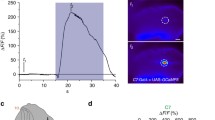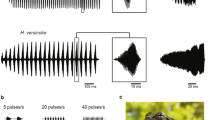Summary
-
1.
Previous work revealed that blowfliesCalliphora vicina can discriminate between alkali chlorides on the basis of salt taste quality, using their labellar taste organ (Maes and Bijpost 1979). This paper and the subsequent one (Maes and Ruifrok 1986) are concerned with the neural coding of salt taste quality in the blowfly. The present paper addresses the possibility of temporal coding. Two modes of temporal coding are considered: salt taste quality may be encoded in the over-all time course of the response, or in its fine-grain temporal pattern. The methodology of analyzing temporal characteristics receives special attention.
-
2.
Data obtained are responses of salt receptor cells in 89 labellar taste hairs to a reference stimulus (lM KCl) and to a doubling concentration series of a test salt (LiCl, NaCl, KCl, RbCl or CsCl). Times of occurrence of salt receptor spikes were measured in the first 500 ms after stimulus onset, using an ‘electronic ruler’ at 0.2 ms resolution.
-
3.
Analysis of over-all time course. Responses were converted into adaptation curves, i.e., curves of momentary firing frequency (reciprocal of interspike interval) vs time after stimulus onset. Mean adaptation curves for the reference stimulus fitted neatly into the array of curves for KCl, RbCl and CsCl as test salt, but seemed to adapt somewhat slower than the curves for LiCl and NaCl (Fig. 2). The significance of these deviations could not be assessed, however.
-
4.
We then tried to quantify adaptation curve shapes by iterative curve fitting of nine mathematical functions. This attempt was not very successful, because either the functions did not fit well to all curves, or the parameters attained inconsistent values (Tables 1, 2).
-
5.
A more robust quantification of the shape of the adaptation curve was provided by the ‘shape factor’ SF (ratio of spike rates in the 0–125 ms and 125–500 ms intervals), together with the mean spike rate SR in the 0–500 ms interval. In the SF-SR plane, the point representing the reference was on the trajectories for KCl, RbCl and CsCl, but significantly outside those for LiCl and NaCl (Fig. 4). The differences presumably arise from the different diffusion coefficients of these salts.
-
6.
Analysis of fine-grain temporal patterning was restricted to the pseudo-stationary tonic response phase (150–500 ms). Interspike interval distributions and serial correlations of orders 1 to 10 were obtained. No salt-specific differences were found (Figs. 5–7).
Similar content being viewed by others
Abbreviations
- c.v. :
-
coefficient of variation
- rms error :
-
rootmean-square error
- SF :
-
shape factor
- SR :
-
mean spike rate
References
Atema J (1975) Stimulus transmission along microtubules in sensory cells: An hypothesis. In: Borgers M, De Brabander M (eds) Microtubules and microtubule inhibitors. North Holland Publ Co, Amsterdam, pp 247–257
Bowdan E (1984) Electrophysiological responses of tarsal contact chemoreceptors of the apple maggot flyRhagoletis pomonella to salt, sucrose and oviposition-deterrent pheromone. J Comp Physiol A 154:143–152
Covey E (1980) Temporal neural coding in gustation. Ph D Dissertation, Duke University. (Cited in: Di Lorenzo and Schwartzbaum 1982)
Den Otter CJ (1972) Differential sensitivity of insect chemoreceptors to alkali cations. J Insect Physiol 18:109–131
Den Otter CJ (1981) Mechanisms of stimulus transduction in chemoreceptors. In: Laverack MS, Cosens DJ (eds) Sense organs. Blackie, Glasgow, pp 186–215
Den Otter CJ, Van der Poel AM (1965) Stimulation of three receptors in labellar chemosensory hairs ofCalliphora erythrocephala Mg. by monovalent salts. Nature (Lond) 206:31–32
Dethier VG (1974) Sensory input and the inconstant fly. In: Barton Browne L (ed) Experimental analysis of insect behaviour. Springer, Berlin Heidelberg New York, pp 21–31
Dethier VG (1976) The hungry fly. Harvard University Press, Cambridge MA
Dethier VG, Bowdan E (1984) Relations between differential threshold and sugar receptor mechanisms in the blowfly. Behav Neurosci 98:791–803
Dethier VG, Crnjar RM (1982) Candidate codes in the gustatory system of caterpillars. J Gen Physiol 79:549–569
Dethier VG, Schoonhoven LM (1969) Olfactory coding by lepidopterous larvae. Entomol Exp Appl 12:535–543
Di Lorenzo PM, Schwartzbaum JS (1982) Coding of gustatory information in the pontine parabrachial nuclei of the rabbit: Temporal patterns of neural response. Brain Res 251:245–258
Gillary HL (1966) Stimulation of the salt receptor of the blowfly: III. The alkali halides. J Gen Physiol 50:359–368
Heck GL, Erickson RP (1973) A rate theory of gustatory stimulation. Behav Biol 8:687–712
Hodgson ES, Lettvin JY, Roeder KD (1955) Physiology of a primary chemoreceptor unit. Science 122:417–418
Maes FW (1977a) Simultaneous chemical and electrical stimulation of labellar taste hairs of the blowflyCalliphora vicina. J Insect Physiol 23:453–460
Maes FW (1977b) ‘Nonblocking’ a.c. preamplifier for tip recording from insect taste hairs. Med Biol Eng Comput 15:470–471
Maes FW (1980) Neural coding of salt taste quality in blowfly labellar taste organ. In: Van der Starre H (ed) Olfaction and taste, vol 7. IRL Press Ltd, London, pp 123–126
Maes FW (1982) Temporal coding does not account for salt taste quality discrimination in blowfly. Abstr 4th Annu Meet Assoc Chemorec Sci, Sarasota FL, p 18
Maes FW (1984) A neural coding model for sensory intensity discrimination, to be applied to gustation. J Comp Physiol A 155:263–270
Maes FW (1985) Response noise affects the graphical evaluation of response versus concentration curves. Chem Senses 10:23–34
Maes FW, Bijpost SCA (1979) Classical conditioning reveals discrimination of salt taste quality in the blowflyCalliphora vicina. J Comp Physiol 133:53–62
Maes FW, Den Otter CJ (1976) Relationship between taste cell responses and arrangement of labellar taste setae in the blowflyCalliphora vicina. J Insect Physiol 22:377–384
Maes FW, Erickson RP (1984) Gustatory intensity discrimination in rat NTS: A tool for the evaluation of neural coding theories. J Comp Physiol A 155:271–282
Maes FW, Ruifrok ACC (1986) Neural coding of salt taste quality in the blowflyCalliphora vicina. II. Ensemble coding. J Comp Physiol A 159:89–96
Maes FW, Vedder CG (1978) A morphological and electrophysiological inventory of labellar taste hairs of the blowflyCalliphora vicina. J Insect Physiol 24:667–672
Nagai T, Ueda K (1981) Stochastic properties of gustatory impulse discharges in rat chorda tympani fibers. J Neurophysiol 45:574–592
Ogawa H, Yamashita S, Sato M (1974) Variation in gustatory nerve fiber discharge pattern with change in stimulus concentration and quality. J Neurophysiol 37:443–457
Perkel DH, Bullock TH (1969) Neural coding. Neurosci Res Symp Summ 3:405–527
Pietra P, Miraldi A, Taglietti V (1972) Pulse coding in the gustative afferent fibres of the frog gustatory system. Pflügers Arch 331:307–314
Pietra P, Tanzi F, Malacrida A (1976a) Sugar discriminating properties in single tarsal hairs ofPhormia regina. Entomol Exp Appl 19:172–178
Pietra P, Tanzi F, Violante A, Crnjar R (1976b) Salt discriminating properties in single tarsal hairs ofPhormia regina M. Boll Soc Ital Biol Sper 52:1782–1788
Rees CJC (1968) The effect of aqueous solutions of some 1∶1 electrolytes on the electrical response of the type 1 (‘salt’) chemoreceptor cell in the labella ofPhormia. J Insect Physiol 14:1331–1364
Sanderson AC, Kozak WM, Calvert TW (1973) Distribution coding in the visual pathway. Biophys J 13:218–244
Sato T (1976) Does an initial phasic response exist in the receptor potential of taste cells? Experientia (Basel) 32:1426–1428
Sato T (1977) An initial phasic depolarization exists in the receptor potential of taste cells. Experientia (Basel) 33:1165–1167
Steinhardt RA (1965) Cation and anion stimulation of electrolyte receptors of the blowfly,Phormia regina. Am Zool 5:651–652
Stürckow B (1960) Elektrophysiologische Untersuchungen am Chemorezeptor vonCalliphora erythrocephala Meigen. Z Vergl Physiol 43:141–148
Van der Molen JN, Van der Meulen JW, De Kramer JJ, Pasveer FJ (1978) Computerised classification of taste cell responses. J Comp Physiol 128:1–11
Van der Molen JN, Nederstigt LJA, Veenman CL (1985) Variability in blowfly taste responses. J Comp Physiol A 157:211–221
Van der Wolk FM, Koerten HK, Van der Starre H (1984) The external morphology of contact chemoreceptive hairs of flies and the motility of the tips of these hairs. J Morphol 180:37–54
Wilczek M (1967) The distribution and neuroanatomy of the labellar sense organs of the blowflyPhormia regina Meigen. J Morphol 122:175–201
Author information
Authors and Affiliations
Rights and permissions
About this article
Cite this article
Maes, F.W., Harms, G. Neural coding of salt taste quality in the blowflyCalliphora vicina . J. Comp. Physiol. 159, 75–88 (1986). https://doi.org/10.1007/BF00612498
Accepted:
Issue Date:
DOI: https://doi.org/10.1007/BF00612498




